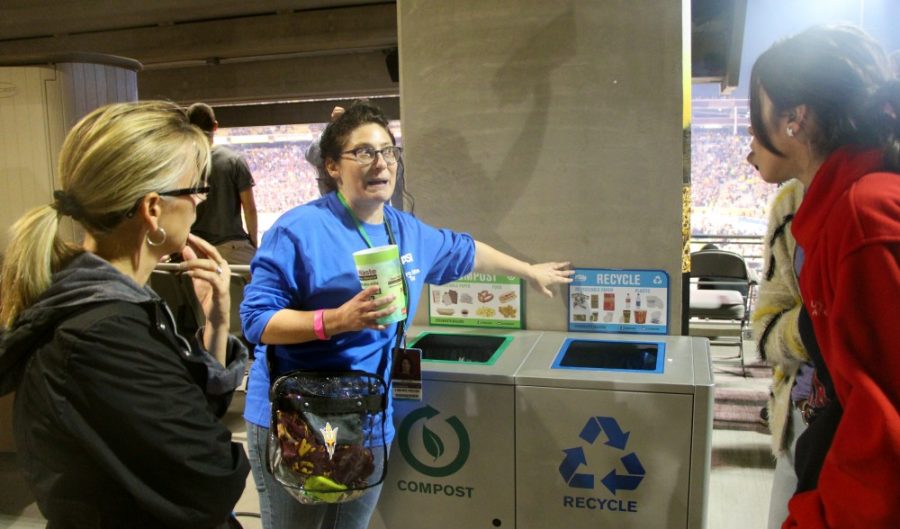A group of students from Students for Sustainability, Greening the Game and Green Team traveled to Arizona State University to tour the school’s newly renovated Sun Devil Stadium and learn about its Zero Waste initiatives Thursday night.
The tour, led by ASU’s Alana Levine, recycling program manager, took the group through the different levels of the stadium as well as the “back-of-the-house” area where waste materials were sent off.
RELATED: Sustainability groups host zero waste Homecoming game
This visit took place during ASU’s home football game against the University of Utah, which ASU had chosen as its reporting game for the Green Sports Alliance’s competition with the Pac-12 Conference. This challenge ranks schools based on outreach, collaboration and diversion rate, or the amount of material diverted from the landfill.
The group of UA students went to ASU to get a different perspective, according to Julia Rudnick, the UA coordinator of campus sustainability programs who attended the trip with the students.
Rudnick said ASU’s sustainability efforts were “amazing” and that she’s “highly impressed.”
According to Levine, who works with the Zero Waste department, all ASU athletic venues, and in turn all the ASU games held in said venues, are public-facing zero-waste, meaning that the goal is to divert material from the landfill. Everything served to the public is compostable or recyclable. This is possible because of ASU’s Zero Waste department’s partnerships with custodial staff and concessions providers.
With a recent stadium renovation, Sun Devil Stadium’s diversion rate hovers around 50 percent, while at other venues, the diversion rate is 70-80 percent according to Levine.
“Once we’re done with all the phases [of renovation] in the stadium, we’re going to be able to achieve those really regular high diversion rates,” Levine said.
While not every game at the UA is zero-waste, Rudnick said it’s a goal that her office is working towards. She said Office of Sustainability recently wrote pre-proposals to the Green Fund to attempt to make all football and basketball games zero-waste environments next year.
Trip attendee Sara Bertram, a molecular and cellular biology junior and chair of the Environmental Health committee with Students for Sustainability, said after seeing ASU’s zero-waste efforts, she wants to work on getting green packaging for items and green purchasing at the UA.
Bertram said she would want a kind of blend of the two schools’ style of sustainability efforts, with ASU’s emphasis on using recycling and composting bins for their products and UA’s “compost coaching,” or having students stationed at bins to educate people about composting and recycling.
Bertram said the main difference between UA and ASU is the amount of student involvement in sustainability efforts like zero-waste games. At the UA, sustainability projects are often student-run, while at ASU, Zero Waste is a department with staff members and student internships.
While the student-run sustainability initiatives are effective, Bertram said she would like to have the student groups work with the school administration more.
RELATED: UA hosts international event to tackle issues of food and water in the desert
“We have Compost Cats, we have Greening the Game, we have the fight and the power,” Bertram said. “It’s more like we just need to translate that to higher levels to get them to support us and a lot of the things we just can’t control.”
Rudnick said she’s especially proud of how UA’s sustainability efforts are “bottom-up,” where students work on sustainability efforts and then “spread the word up.”
As for the future of UA’s and ASU’s relationship with sustainability, Levine said she’d like to see more student collaboration.
“Having the student collaboration is kind of one of my dreams,” Levine said.
Rudnick said the two schools haven’t really worked together before on sustainability initiatives, but they get together a couple times a year and have been communicating more.
“It’s a little awkward being here because it’s like that rivalry, but at the end of the day sustainability doesn’t care about ASU or UA,” Bertram said. “I like that idea of collaboration; that’s really essential to the sustainability conversation.”
Follow Ava Garcia on Twitter.









